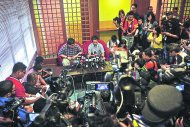
Insiders claim the dexamethasone injected into the world No. 1 was part of the surgical procedure usually carried out if the surgery “under anesthetic took longer than usual” to avoid the patient from suffering from severe nausea and vomiting.
“But the National Sports Institute (NSI) was not informed the drug was administered up until recently,” said an insider close to the investigations.
“Investigators are also probing how traces of the drug lingered in the athlete’s body for more than a month and if other pills or cream, were also used.”
The biological half life of dexamethasone, a lower-strength steroid, is between 36 and 54 hours. It is not a performance-enhancing drug.
Dexamethasone pills and cream are usually prescribed to reduce inflammation and swelling.
Lee was tested during the World Championship semifinal in Copenhagen, Denmark on Aug 30 where sample A of his urine tested positive.
Another source said it was peculiar the drug still existed in Lee’s body for more than a month as recent medical records showed the drug was only administered in July 17.
“What could have happened is that the team that conducted the surgery assume the drug would be flushed out of the system before Lee competed at the World Championships. Thus, they did not see the need of informing any party. But this should not have happened as the NSI must know every single detail.
“This cannot be swept under the carpet.”
When asked of the level of the reading of the drug in sample B of Lee’s urine which was tested in Oslo, Norway last Wednesday, the source said: “It was high enough”.
“Previously, the threshold of traces of the drug was 30 nanograms but the World Anti-Doping Agency (WADA) changed the regulation 18 months ago. Now even a slight trace of the drug is considered positive. It remains unclear if those within NSI were aware of such changes prior to Lee’s saga,” the source said.
BA of Malaysia (BAM), at its press conference yesterday, said it received a letter from Badminton World Federation (BWF) on Friday confirming traces of the drug were seen in sample B of the urine. BAM said it was “at no liberty to reveal the name of the player” adding “the athlete is serving a temporary suspension”.
“We were also informed by BWF this matter will be referred to the BWF Doping Hearing Panel and now due process will take place. The panel will provide the time, date and location of the hearing,” said BAM deputy president Datuk Norza Zakaria.
Norza said the national body was working with Sports Minister Khairy Jamaluddin and has hired London-based lawyer Mike Morgan to assist them.
Norza declined comment when asked about details of the drug and the tests conducted.
“(NSI chief executive officer) Dr Ramlan would be the best person to answer these questions,” he said.
When asked if there was a conflict of interest as he was both NSI chairman and BAM’s anti-doping working committee chairman, he replied: “No”.
BWF has not responded to an email as to when it will meet to discuss the case.












